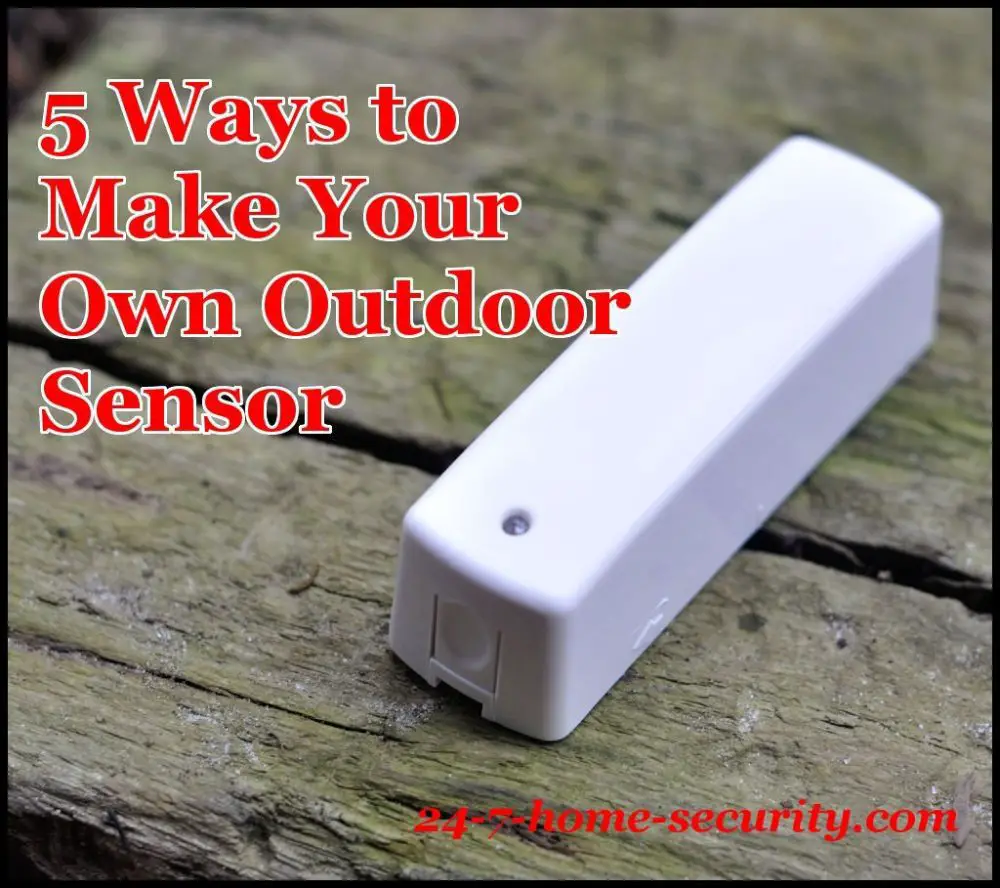Not having any luck finding a Z-wave outdoor door sensor for a gate or pool area?
No worries!
It will require venturing outside of warranty coverage (oh my!) and may reduce battery life a bit. But if that’s not a problem for you, there are several methods that have been proven effective by DIYers before you.
I’ve also written a post about how to make your own smart sensor doorbell which you might want to check later.
Let’s take a look and find the right method for your situation.
First, A Primer on Z-Wave Signal Attenuation
Heads up!
Outdoor installations are always going to be prone to degraded range in rainy weather. A couple of these techniques also add to the attenuation of the wireless signals by adding material around the sensor itself.
Normally, a couple of inches of wood isn’t a problem for Z-Wave signals to pass through. But, add a coating of rain to the outside of a post, and it acts very differently. Remember that the RF will also be attenuated traveling through the rain inside your house as well.
So, depending on your network (how many devices your have and their proximity to your outdoor sensor), you may have connectivity problems.
Unleash the Geek
A helpful figure of merit is the conductivity of a material. In layman’s terms, it tells you how well RF energy can pass through the material.
Here are some selected conductivity values:
| Copper | 6 x 10^7 |
| Air | 3 x 10^-15 to 8 x 10^-15 |
| Water | 5 x 10^-4 to 5 x 10^-2 |
| Damp wood | 10^-4 to 10^-3 |
| Oven dried wood | 10^-16 to 10^-14 |
We’re going to skip the differential equations to compute losses for Z-Wave frequencies through all of these materials for your sake.
The takeaway is:
Water is a decent conductor (halfway between copper and air), and damp wood is comparable to water. So, a brand new post from the store (still pretty wet) is going to be tough on Z-Wave radio signals, as is an older post with rain coating it. So, try to minimize distances between your outdoor installation and the closest Z-wave sensor in your network to overcome losses due to rain and materials.
Using a Recessed Z-Wave Sensor Outdoors
Whether or not a recessed installation will work in your case will depend on where you need to install the sensor. Generally, wooden or plastic gates with large columns will be suitable for a recessed sensor. And, all the warnings about losses due to rain and wet wood certainly apply here too.
This technique relies on the post that you install the sensor in to keep water away from the sensor and supplements that with outdoor caulk, silicone, or RTV to seal the entrance.
Here’s how you do it:
- Drill a hole for the recessed Z-wave sensor in your gate post just like you would in a window or door. You want a tight fit!
- Use a tube of outdoor caulk to seal around the exposed surface of the sensor (vaseline or grease also works well).
- Insert the recessed sensor into the drilled hole.
- Mount the magnet on the gate (moisture isn’t a concern).
It’s that simple. The post keeps the moisture away from most of the sensor and the caulk handles the rest. The down side, of course, is that you’ll have to re-apply the caulk when you change batteries in the sensor. But, you’re talking less than 10 minutes time total during a year for most levels of use.
You could even go cheap on us and use plastic wrap like this guy on the SmartThings forum did, but I can’t imagine that keeping condensation out.
How to Use an Outlet Box to Waterproof a Z-Wave Entry Sensor
The second alternative is to mount the door sensor in a waterproof container. The easiest way to do that is with an outdoor outlet box from your local hardware store.
- Pick up a waterproof, single gang outlet box
from the hardware store (preferably with a thin, plastic outer wall to minimize the distance between the reed and the magnet).
- Use electrical or duct tape OVER the sensor to secure it to the inside of the box.
- Mount the magnet on the gate according to the sensor’s instructions.
- You may get away with double sided foam under the sensor in the box, but any extra gap can lead to unreliable operation. Generally, the supplied magnets are only good to trigger the switch with a 1/4″ inch gap. If your gate or mounting technique makes that impractical, pick up a rare earth magnet like the ones in the image to increase the distance.
- A metal outlet box is a no-no. The losses for the Z-wave signals will be too high.
- A box with a thin wall and mounting right up to the edge of the post is important. If you don’t minimize the gap between the magnet and the reed switch, you’ll have to pick up a stronger magnet!

How to Make an Outdoor Door Sensor with a Waterproof Coating
This one is my personal favorite for an outdoor Z-wave gate sensor. It looks nice, is discreet, and doesn’t have the problems of widening the gap between the magnet and the sensor.
Putting this one together initially and on battery changes takes a little while to get the Plasti Dip coats on and dry, but the finished look is good.
- Apply Plasti Dip to the large part of the sensor using the instructions on the can.
- Mount the sensor as you normally would.
The Plasti Dip and Armor All Custom Shield are practically the same product, and both work well.
How to Use Caulk to Waterproof a Z-Wave Sensor
In the same way that Plasti Dip can be used to waterproof the Z-Wave sensor with the electronics in it, you can also use outdoor caulk to seal any holes and seams on the body of the sensor.
- Put a dab of caulk along any open seams on the sensor.
- Use your finger to wipe off any excess and push the caulk into the cracks and holes.
- Mount the pieces as you normally would.
Of course, you’ll have to redo your caulking job every time you change the batteries, just like the Plasti Dip.
Using a Remote Sensor to Waterproof an Outdoor Z-Wave Entry Sensor
Another option is picking up a standalone contact sensor to connect to a Z-wave entry sensor. By using a sensor remotely, you can place the actual Z-wave sensor out of the elements altogether. Then, the remote switch is wired into your electronics.
All it requires is a door sensor that accepts external inputs. You can check out the comparison table below to find compatible sensors (see the “Notes” column).
Here’s the procedure:
- Mount a contact switch on the gate.
- Mount your Z-wave sensor under an eave or in a waterproof housing in a hidden location.
- Route the cable from the contact switch over to your sensor and connect the wires to the built-in terminals.
Now, the contact switch will trigger the Z-wave sensor which then lets your security system or hub know what’s going on.
One word of caution:
The distance that you can route the cable for your remote sensor is limited for it to work reliably. So, read the specifications before buying and plan accordingly.
Please share this with other home automation and security nuts!
Compare Z-Wave Door & Window Sensors
| Entry Sensor | Protocol | Cost ($) | Size | Avg. Rating | Notes |
|---|---|---|---|---|---|
| Aeotec Z-Wave Door-Sensor | Z-Wave | 38 | 1.1 x 0.8 x 2.9 in | 3.5 | |
| Aeotec Recessed Sensor | Z-Wave | 40 | 1 x 2.8 in | 4 | |
| Ecolink Door/ Window Sensor | Z-Wave | 35 | 3.25 x .88 x .88 in | 4.5 | |
| Enerwave Door/Window Sensor | Z-Wave | 33 | 2.8 x 2.7 x 1.8 in | 5 | |
| Everspring HSM-02-0 | Z-Wave | 29 | 1.2 x 2.75 x .45 in | 4 | - External inputs |
| Fibaro Motion Sensor | Z-Wave | 50 | 3 x .67 x .75 in | 4.9 | - External inputs |
| Linear WADWAZ-1 | Z-Wave | 32 | 0.9 x 3.4 x 0.8 in | 3.5 | |
| Monoprice Door & Window Sensor | Z-Wave | 25 | 1.8 x 4.1 x 1.4 in | 4.4 | |
| Philio PSM02 Multi-Sensor | Z-Wave | 60 | 1 x 2.6 x 5.35 in | 2 | - Light - Temp. |
| Schlage RS100 Sensor | Z-Wave | 33 | 1 x 3.5 x 1.8 in. | 4.4 | - External inputs |
| SmartThings Multipurpose Sensor | Zigbee | 40 | 1.9 x 1.9 x .57 inches | 4.6 | - Vibration - Tilt - Orientation - Temp. |
That about does it. If you want some more tips on keeping your home safe, I wrote a big guide to DIY security fixes that you can do for little or no money that you just have to read.

Hi, I’m Jody. I graduated with honors with a Masters of Science in Computer Engineering and have over 15 years of experience working as an engineer with electronics products. I’m a lifelong learner and tinkerer and enjoy automating things around the house so I can solve bigger problems than getting out of bed to check if the garage door is closed . . . like too little sleep!


